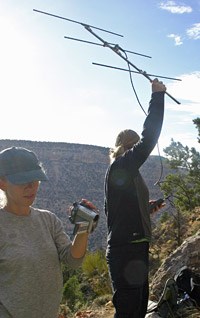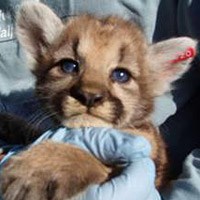|
Lori Rome, Seasonal Supervisor - Interpretation
Before dawn on a morning in July 2007, a small group gathered at the Science and Resource Management Complex to search for the future. We were looking to find Grand Canyon’s youngest predators, mountain lion kittens of collared female P13. 
Global positioning system data from P13’s radio collar, collected as part of Grand Canyon National Park’s lion research program led by biologist Eric York, showed that she kept returning to a specific location for several weeks, which could only mean one thing: kittens. Eric estimated that the kittens would be approximately five weeks old, the perfect age to capture and weigh, sex and tag them. If the kittens got much older, they would be too large to handle safely. It was the fourth day in a row that we had tried to find the kittens. Previous attempts had been stopped because telemetry data showed that the mother was in the vicinity of the den, making an attempt to locate it too risky. Eric led our group that summer morning. National Park Service biologists Hattie Oswald and Tim Bowden were along to help with the effort to locate and tag the kittens if we found them. Frank Wallander from the Division of Facility Maintenance and I from the Division of Interpretation joined the group to help photo-document the potential discovery and to assist in any way we could. For the last two years, Eric and I had worked together, sharing a passion for lions. He did lion research, and I did education and interpretation. That morning, I was thrilled beyond words about the prospect of seeing young kittens in their den. The day was to become the best of my National Park Service career. We drove in darkness down a bumpy dirt road far from Grand Canyon Village and parked at a nondescript spot in the heart of the pinyon-juniper forest. Eric took out the handheld GPS unit and typed in the coordinates. Hattie gathered the radiotelemetry equipment, and Tim grabbed the gloves and some other equipment. We started hiking through the forest by headlamp to the area that Eric thought may contain P13’s den site. We walked over elk tracks and scat, and avoided the prickly pear cactus and low-hanging branches. The earth was damp from monsoon rains the previous day. 
After about 45 minutes we stopped. The telemetry antenna went up, and to our luck, silence. No radio signal meant P13 was not in the vicinity of the potential den site. We could continue. A hint of dawn lightened the horizon as we dropped into the canyon. The hiking was rough and we occasionally slipped on steep slopes or were jabbed by brush. The side canyon was filled with possible den sites. A lion kitten could hide from the monsoon rains or stay out of the noonday sun in the rocky crags and ledges. Our mission was to search every nook and cranny in the rocks to see if it might hold the future top predators of the canyon. After a few hours of searching, Eric called out to everyone. It was getting warm as the sun climbed into the sky. We had found no kittens, no den site. We gathered around a large boulder to discuss what to do next. 
Eric could tell the kittens had been in the area. He pointed out the stomped-down earth and exposed soil, and picked up a small piece of fur. Eric showed us how the kittens could have used the site and where they might hide. Then he called out, “Oh, yikes, there’s one in here!” The litter had retreated into the back of the den. We crawled on our bellies about 5 feet into a den barely 10 inches high. Lying in the dirt, I started the video camera. Through the viewfinder, I saw a ball of fur and bright blue eyes. 
The largest kitten was 10 pounds, and the runt was barely 5 pounds. Each had those brilliant blue eyes, spotted fur and that heartwarming baby animal mystique. 
P20 was small and not nearly as aggressive as the other two. She still tried to bite Tim, to no avail, while he held her as Eric placed the ear tags. It reminded me of when I had my own ears pierced. It stung! P20 flexed her tiny retractable claws and hissed. The ear tags identify the kittens so researchers can track them to see if any make it into adulthood. Skin tissue from the ear tagging was placed in an envelope to be sent for DNA testing, which may allow identification of the father of these young lions. With the kittens safely returned to the den, we packed our gear and started our hike out. It was midmorning and thunderheads began to boil overhead. Before leaving the den site, I paused and looked back to the boulder that housed the young lions. It was the kind of day that a ranger lives for — to be a part of research, and to witness the miracle and beauty of the natural world. I knew that fewer than 20 percent of mountain lion kittens make it to adulthood, but I could not help hoping that somehow this whole set of siblings might survive. They had a safe home with a fantastic view, a great food source, and the benefit of a dedicated mother to care for them and guide them. I hoped that one of them might raise her own kittens in this very side canyon one day. As we hiked out of the canyon, I took comfort in knowing that Grand Canyon’s protected landscape offered the kittens a bright future with a chance to be part of the natural web of life. 
Grand Canyon Mountain Lion Program Archive Mountain Lion Research (2009) Download these articles as they appeared in the Summer 2008 Nature Notes (576kb PDF File) Animal Check Lists Amphibians of Grand Canyon NP (31kb PDF File) Birds of Grand Canyon NP (154kb PDF File) Fish of Grand Canyon NP (36kb PDF File) Mammals of Grand Canyon NP (69kb PDF File) Reptiles of Grand Canyon NP (52.5kb PDF File) Grand Canyon Invertebrate Species Collection (1.7MB XLS File) Grand Canyon Vertebrate Animal Species List (223kb PDF File) Grand Canyon Threatened & Endangered Species List (52kb PDF File) Arizona Game and Fish Web Site |
Last updated: July 28, 2015
